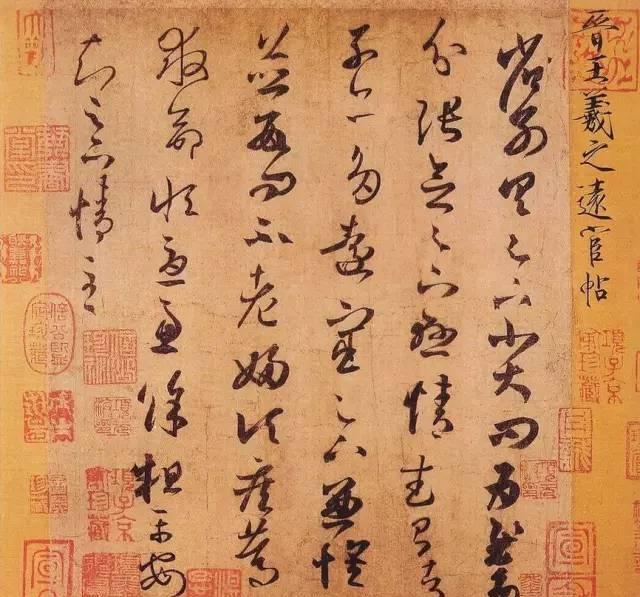
Figure 1 of the Distant Eunuch Thesis
Also known as "Provincial Posts", on paper.
Length 24.8cm, width 21.3cm, 6 lines, 53 characters cursive
Collection of the National Palace Museum in Taipei
This post was composed by Wang Xizhi in his later years, is a representative work of Wang Xizhi cursive, "Yuan Eunuch Thesis" with delicate and rich pen, the rhythm of the action is clear, almost in every line there are obvious folding and lifting, linear angles are prominent, the block effect is strong, the context of the pen is explained very clearly, reflecting the richness of Wang Xizhi's cursive lines - the use of the pen in the circle, square fold, joint, cut, light and heavy, press and other opposing factors in the process of starting, closing, and moving the pen. Secondly, factors such as the staggered size of the structure and the chapter, the interspersed left and right, the up and down displacement, etc., also increase the sense of movement of the characters, appearing virtual and flexible, full of vitality. The richness and variety of wang character brushwork can be seen here.
There are four ways of connecting in the "Distant Eunuch Thesis": real connection, virtual connection, tie-in connection and comprehensive connection.
Really connected
Figure 2
"Provinciality" as the opening word, with a thick pen and tightly linked. The long apostrophe of the word "province" (Figure 2) is wide and has a clear curvature, corresponding to the outer circular arc of the "don't" word ending pen, and the connecting line between the two words takes a short straight trend, avoiding the repetition of the arc line.
Virtual connection
Figure 3
There are two kinds of imaginary links, connecting horizontal painting and connecting dot painting.
Connect the horizontal drawings. The word "help" (Figure 3) is rounded, and the pen rules of Huai Su's "Self-Narration" seem to come out of this. The word "save" is flipped to the left, there is a clear sense of pause, and the vertex is obvious. The connection between the two words is in a large left arc, and the gestures are soothing.
Figure 4
The connecting line of the word "zi also" (Fig. 4) is thin and thick, until the "also" word structure line, the transition is natural.
Figure 5
Connect the dot paintings. The word "foot" (fig. 5) is mainly shaped by dotted lines and is closely embellished. After the word "foot" is written, it is immediately followed by the upper dot of the word "down" (taking the cursive method).
Connect
Figure 6
There are two kinds of connecting dot painting and connecting horizontal painting.
Connect the dot paintings. The two sets of "foot" (Figure 6) are similar in pen, but the linear shape is different. The word "foot" closes the lower left side of the pen with a sharp edge, leading to the beginning of the word "down".
Figure 7
Unlike the horizontal development of the glyphs in this work, the word "love to" (Figure 7) takes a longitudinal shape, and the inside of the word is also more broken.
Figure 8
The word "concurrently nostalgic" (Figure 8) is used with a pen to pave a lot, and the horizontal painting is flat, which has the meaning of a book. The word "concurrent" brings out the shape of the long triangle in the lower left of the pen.
Figure 9
Figure 10
Connect the horizontal drawings. There are two groups: "Small and Large" (Figure 9) and "Diseased" (Figure 10). The "small" word closes almost to the beginning of the "big" word. The word "disease" is extremely short at the end, but the obvious connection with the "Du" character makes the two words echo each other. It should be noted that the horizontal paintings of these two words are obviously concave.
Integrated connected
Figure 11
The first two sets of integrated couplets are in the form of continuous linkages. The overall left slant of the line axis of "Reading Foot Hanging" (Figure 11), the closing and starting strokes between the first three words have implicit forward guidance, and the echo between "down" and "hanging" is more obvious, especially the "hanging" word starting pen, in order to take care of each other, its starting pen direction changes to the lower right oblique.
Figure 12
"Rough peace" (Figure 12) as a group of words, closely contiguous, "thick" and "flat" words have a small edge, in order to echo each other.
Figure 13
"And count ask no" (Figure 13) is a combination of conjunction and imaginary connection, and the word "and" in the word "and count" can be connected to the pen and the word "number" can be connected into an obvious straight line, but the middle is just a void. The word "count" closes with a short, vigorous echo line that connects with the word "ask". Although the last two words are far away, the lower right oblique of the "no" word is intrinsically connected to the word "ask".
The graphics and text originate from the Network, if there is infringement, please contact to delete!